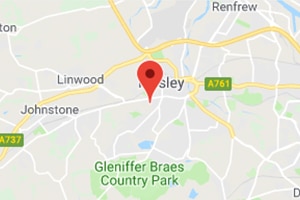What Is the Proper First Aid for Choking?
Choking happens when small objects block the airway. Children are more vulnerable to choking since they put random things into their mouth.
Choking is dangerous, as it cuts off oxygen to the brain.
The universal sign indicating someone is choking is the hands clasping their throat.
If you can see them experiencing difficulty breathing, persistent cough, their skin getting pale, and they are getting unconscious.
Perform the aid advice of the Red Cross, the five and five methods.
Slap their back using the heel of your hands in between the shoulder blades, do this five times.
What Are the 4 Actions in Order When Dealing With a Choke Victim?
This is a simplified four actions from St. John Ambulance when responding to a choking victim:
- Ask them if they are choking: They might still clear out the blockage if they can cough or talk.
- Encourage them to cough: Coughing may remove the obstruction.
- Hit them: If coughing fails, give them five sharp back blows.
- Squeeze it: Give five abdominal thrusts and wrap your arms around their waist. Put your clenched fist between their belly button and the bottom of the chest.
With your other hand, clutch your fist and pull sharply inwards and upwards five times. Then recheck the mouth.
What Is the Proper First Aid for Choking Adults?
From the St. John guide, if there’s partial airway obstruction, the choking adult can still breathe, though there may be noisy breathing.
They can clear out small objects by coughing and breathing, so avoid giving them a back blow as it may lead to total blockage.
Ask first the choking adult to find out if their airway is blocked. Conduct airway establishment if they cannot answer or breathe properly.
1: Heimlich Manoeuvre
Follow the steps:
- Stand behind the person, wrap your arms on their waist, and lean forward.
- Place your clenched fist on the abdomen above the person’s navel.
- Use one hand to clutch your fist and press hard into the abdomen in an inward and upward motion.
- Do this step five times. If the object is still causing a blockage, repeat the method five times more.
- If the person loses consciousness, use your finger to remove the blockage.
- If you’re helping pregnant women, place your hand higher at the base of the breastbone.
TAKE NOTE: Be cautious not to push the object further and call for medical help to begin CPR.
2: CPR
For cardiopulmonary resuscitation, follow these methods:
- Set down the person on their back on a firm surface.
- Kneel beside the unconscious person and put your hand in between the chest with the palm facing down.
- Conduct chest compressions. Put your free hand on the other, then push down fast at 100 times per minute.
- Do this process repeatedly until the person begins to breathe properly.
What Is the Proper First Aid for a Choking Infant?
Children are prone to choking as they tend to swallow random things.
When this happens, check the mouth; if you can see the blockage at the back of the throat, sweep the object using your finger.
However, if the blockage is not visible, don’t try to finger sweep, as you might push it further.
The British Red Cross recommends the following steps for a choking child.
1: Give Up to Five Back Blows
Hold and support the baby face down on your thigh with their upper body and head lower than their bottom.
Then, hit them tightly on their back in the middle of the shoulder blades. Do this five times.
If the back blow didn’t work, proceed to step 2.
2: Give Up to Five Chest Thrusts
Turn the baby over, facing upwards, and give up to five chest thrusts. Make sure that you give support to the head.
Put two fingers between their chest below the nipples and push sharply downwards five times.
3: Call for Medical Attention
Keep doing the back blows and chest thrusts until you clear the airway.
Call for medical help, especially if the child’s unresponsive.
NOTE: When a child is choking, perform only the Heimlich maneuver and not the five-and-five technique.
How Many Are Back Blows for Choking Needed?
When someone is choking, give up to 5 back blows and abdominal thrusts.
Provide five separate back blows in the middle of the person’s shoulder blades using the heel of your hand.
You can perform five abdominal thrusts or the Heimlich maneuver.
Take turns between 5 blows and 5 abdominal thrusts until the obstruction is cleared out.
What Are the Different Types of Choking?
If someone is choking mildly, encourage them to cough. While for severe choking, do back blows and abdominal thrusts.
Mild Choking
When the airway is partly blocked, the person can still cough and breathe. So they can remove the blockage.
You can aid mild choking and encourage them to cough until they clear the blockage.
You can also tell them to spit out the thing if it’s in their mouth.
Remember, DON’T place your fingers in their mouth as they might munch you.
If the coughing and spitting do not do any good, begin the back blows.
Severe Choking
When a person’s airway is completely blocked, they cannot speak or breathe, so they will need your help to prevent losing consciousness.
Do the back blows and abdominal thrusts. Stand behind the person and support their chest with one hand. Then bend them forward so the object will come out and not move farther.
Give up to 5 sharp blows in the middle of their shoulder blades with the heel of your hand.
If there’s still an object blocking, give up to 5 abdominal thrusts.
Frequently Asked Questions
Here are some additional facts that you must remember:
Can You Get Complications From Choking?
You may experience throat irritation, throat damage, or worse, death from asphyxiation.
When the airway is closed, insufficient oxygen reaches the lungs, and brain damage can happen in 6 minutes.
What Should I Do if the Person Becomes Unresponsive?
Perform the standard CPR with chest compressions and rescue breaths.
Continue doing this until the medical rescuer arrives.
How Can I Prevent Choking?
Prevent your child from getting choked by restricting any choking hazards. This includes coins, erasers, buttons, and anything 1.75 inches in size.
Cut their food into smaller pieces, making it easier for them to swallow.
Save yourself from choking by thoroughly chewing your food and avoiding talking while eating.
Conclusion
Consider enrolling in first aid courses and learn about back blows and abdominal thrusts.
You can be the one to save children, your family, or anyone by preventing complications from choking.
As they say, prevention is better than cure.
Our FAIB-accredited First Aid Training Courses are designed to make it easy to train your company’s first aiders, with both the 1-day emergency course and the 3-day first aid course can be delivered on your business premises or at one of our UK locations.

